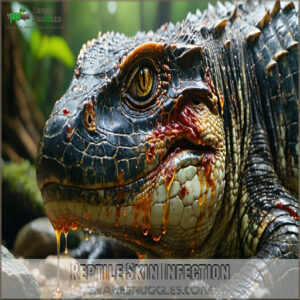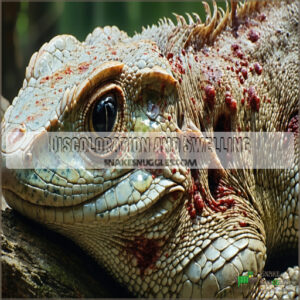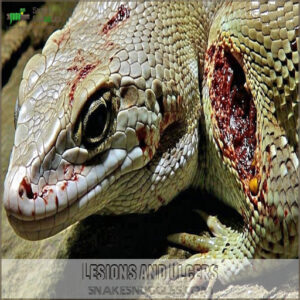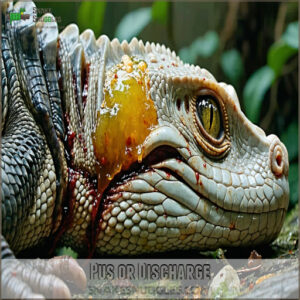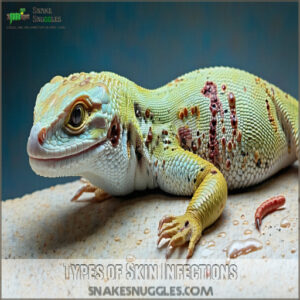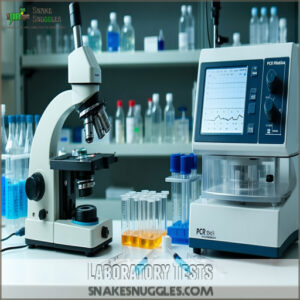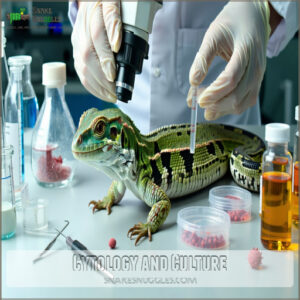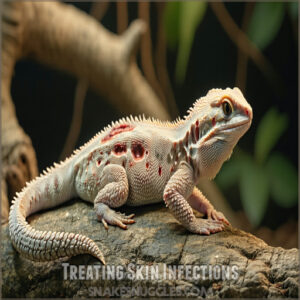This site is supported by our readers. We may earn a commission, at no cost to you, if you purchase through links.
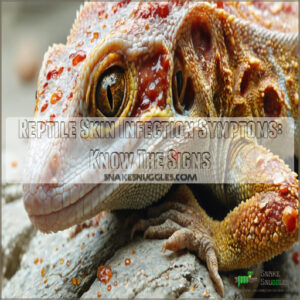 Spotting reptile skin infection symptoms early can save you and your scaly friend a lot of stress.
Spotting reptile skin infection symptoms early can save you and your scaly friend a lot of stress.
Look for discoloration (red, yellow, or flaky patches), swelling, or crusty lesions. Pus, discharge, or unpleasant odors around wounds? That’s usually trouble.
Behavioral changes, like hiding or unusual lethargy, can also be big red flags. These symptoms could point to bacterial infections, fungal issues, or pesky parasites.
Think of it as your reptile’s way of waving a red flag for help! Keep an eye out—early treatment is key to giving your reptile the care it needs to keep those scales happy and healthy.
Table Of Contents
- Key Takeaways
- Reptile Skin Infection
- Identifying Infection Symptoms
- Types of Skin Infections
- Diagnosing Skin Infections
- Treating Skin Infections
- Frequently Asked Questions (FAQs)
- How do you know if a reptile has an infection?
- What are the symptoms of monkey pox?
- What should I do if my reptile has a skin infection?
- What are skin and shell infections in reptiles?
- How do you know if a reptile has septicemia?
- How do you know if a reptile has mites?
- What are the symptoms of dermatitis in reptiles?
- What are the symptoms of herpesvirus in reptiles?
- What are the symptoms usually appear as skin infections such as?
- What are the symptoms of cryptosporidium in reptiles?
- Conclusion
Key Takeaways
- Look for discoloration, swelling, or crusty lesions on your reptile’s skin, and don’t ignore pus, discharge, or foul smells around wounds.
- Watch for behavioral changes like hiding, lethargy, or loss of appetite, as these might signal infections needing immediate attention.
- Keep your reptile’s environment clean, regulate temperature and humidity, and address poor hygiene or stress to prevent infections.
- Act quickly by consulting a vet for proper diagnosis and treatment, including antibiotics or antifungal solutions, to stop infections from worsening.
Reptile Skin Infection
You’ll want to recognize the signs of reptile skin infections, as they can be caused by bacteria, fungi, or parasites, and can quickly become serious if left untreated.
By understanding what to look for, you can take action to protect your reptile’s health and prevent infections from taking hold.
Bacterial Infections
You’re dealing with bacterial infections, a common reptile skin infection symptom.
Bacterial causes can lead to bacterial dermatitis, so infection control is essential.
Antibiotic use may be necessary to combat bacterial strains, supporting your pet’s immune response to reptile bacterial diseases and bacterial skin disease.
Fungal Infections
You’re likely to encounter fungal infections, caused by fungal spores, in your reptile.
Fungal lesions and skin fungus can appear, requiring antifungal treatments and yeast control measures for prevention, to manage reptile skin infection symptoms and fungal dermatitis, and facilitate mold prevention.
Understanding the importance of proper reptile skin care is vital for preventing fungal infections in reptiles.
Parasitic Infestations
You’re on the lookout for parasitic infestations in reptiles.
- Mite Control
- Tick Removal
- Lice Treatment
- Flea Prevention
Flea Prevention helps with parasite management and reptile mites, making ectoparasite management and parasitic infestation treatment easier.
Common Causes
You’re probably wondering what sparks reptile skin infection.
Common causes include poor hygiene, nutrient deficiency, environmental stress, and genetic predisposition, which can lead to immune suppression, making your pet susceptible to bacterial or fungal infections.
Skin lesions, a common reptile skin condition, can result from these factors, highlighting the importance of understanding reptile skin infection causes to provide proper care.
Identifying Infection Symptoms
You’ll want to recognize the signs of infection in your reptile, such as discoloration, swelling, or lesions, to get them the help they need.
By knowing what to look for, you can identify potential issues early on and take action to prevent more serious problems from developing, which is crucial for the health of your reptile, involving early action.
Discoloration and Swelling
You’re checking your reptile for signs of infection. Discoloration and swelling are key indicators.
Here are signs to watch:
- Color Changes
- Skin Bumps
- Inflammation Signs, indicating tissue damage and potential reptile skin infection.
Reptile owners should be aware of reptile skin disorders to provide proper care.
Lesions and Ulcers
You notice lesions and ulcers on your reptile’s skin, a sign of infection.
| Type | Cause | Treatment |
|---|---|---|
| Skin Lesions | Bacterial, fungal | Wound Care |
| Skin Ulcers | Infections | Ulcer Treatment |
Pus or Discharge
Pus formation or unusual discharge around wounds or skin ulcers is a big red flag for a reptile skin infection.
Discharge types can vary, from watery to thick and yellowish, often signaling abscesses or bacterial infections.
Proper wound care is critical—pus discharge can indicate deeper issues requiring abscess treatment.
Trust your gut and consult a vet quickly!
Identifying skin infection symptoms is essential for effective treatment and preventing further complications.
Behavioral Changes
When your reptile starts spending too much time hiding or shows signs of lethargy, it might be more than just a bad day.
Look out for behavioral changes like appetite loss, social withdrawal, or a noticeable activity decrease.
Stress signals, such as weight loss or diarrhea, often scream, "Something’s wrong!" and indicate that you should catch these shifts early to keep your pet healthy.
Types of Skin Infections
Reptiles can develop different types of skin infections, including bacterial, fungal, and parasitic ones.
Each type has unique symptoms and causes, but they all require quick action to keep your scaly friend healthy.
Dermatitis
Dermatitis in reptiles often shows up as itchy scales, scaly patches, or general skin irritation.
It can stem from bacterial dermatitis, fungal dermatitis, or poor husbandry.
Watch for redness, skin lesions, or signs of discomfort.
Clean habitats and proper humidity are key for redness treatment and avoiding dermatitis causes.
Spotting symptoms early prevents the spread of reptile skin infections.
Mycoses
Mycoses show up when fungal spores invade your reptile’s skin, leading to fungal infections like fungal dermatitis.
Watch for mycotic lesions or flaky patches. Left unchecked, these can spread fast.
Look for:
- Thickened scales or peeling skin
- Visible fungal growth or discoloration
- Areas your reptile keeps scratching
- Sores that don’t heal properly
Early antifungal treatments are your best shot. Understanding snake skin infections is essential for effective treatment and prevention.
Ophidiomycosis
Snake fungal disease, better known as Ophidiomycosis, hits North American snakes hard.
Caused by the fungus Ophidiomyces, it creates crusting skin lesions, making your snake’s skin look rough or patchy.
Left untreated, fungal spores can spread and worsen, and spotting this early is key—watch for flaky patches or odd behavior.
This stubborn skin fungus thrives in poorly managed environments, so keep conditions clean, and understanding reptile mycotic diseases is essential for effective prevention and treatment, which can be found by visiting the link to reptile mycotic diseases to learn more about effective prevention and treatment.
Scale Rot
When skin lesions creep in, scale rot might already be at play.
Poor hygiene or damp habitats turn small issues into bigger bacterial or fungal infections.
Keep your reptile healthy with these basics:
- Rot prevention: Dry, clean enclosures.
- Wound healing: Treat sores quickly.
- Scale care: Check for damage often.
- Reptile hygiene: Regular enclosure cleanings save headaches.
Diagnosing Skin Infections
When your reptile’s skin looks off, figuring out the problem starts with a close look for tell-tale signs like discoloration, swelling, or lesions.
Lab tests, like cytology and cultures, can confirm the type of infection and guide the right treatment.
Visual Examination
A quick visual check can reveal reptile skin infection symptoms.
Watch for color changes, unusual pattern alterations, or scale damage. Skin lesions, like cuts or sores, are red flags too.
Gently examine the texture; scaly skin often feels rough or flaky.
| Symptom | What to Look For |
|---|---|
| Color Changes | Dark or pale patches |
| Pattern Alteration | Irregular patterns |
| Scale Damage | Lifting or peeling |
| Skin Lesions | Open wounds/sores |
Visual clues help spot issues early for proper skin infection treatment.
Laboratory Tests
Sometimes, a deeper dive is essential to figure out what’s going on.
Lab tests like PCR testing, microscopy, and serology pinpoint viruses, bacteria, or fungi.
Here’s what might help:
- Microbial cultures: Grow and identify infection-causing microbes.
- Histology: Study tissues for damage.
- Biopsy: Spot internal issues.
- Lab analysis: Match symptoms with pathogens.
Lab work clears up mysteries!
Understanding PCR testing methods is vital for accurate diagnoses.
Cytology and Culture
Cytology and culture are your go-to tools for understanding infections.
A vet might examine cells (cytology) or grow microbes in culture media to pinpoint the cause.
Add gram stains and histopathology for deeper insight.
These tests guide treatment, ensuring the right fix for your reptile’s woes.
| Tool | Purpose | Example Use |
|---|---|---|
| Cytology | Cell Sampling | Checking bacterial presence |
| Culture | Microbial Tests | Identifying infection type |
| Histopathology | Tissue Analysis | Detecting underlying conditions |
Treating Skin Infections
Treating skin infections in reptiles means combining proper medication, wound care, and changes to their environment.
You’ll need to act quickly to address the infection and prevent it from spreading or worsening.
Antibiotic Therapy
Antibiotic therapy can work wonders for bacterial skin diseases in reptiles when done right.
Start with bacterial sensitivity tests to choose the best treatment, and use systemic antibiotics or antibiotic ointments, sticking to prescribed dosages to avoid antibiotic resistance.
Watch for medication interactions and follow the treatment duration closely, as it’s not just a quick fix—follow-through is key.
Reptile owners can research reptile antibiotic options to find suitable treatments for their pets.
Antifungal Treatments
When bacterial fixes don’t work, fungal infections might be the issue.
Antifungal creams or topical ointments tackle many cases, while oral supplements help for tougher infections.
Some owners explore natural remedies, but stick to vet-approved fungal infection treatments.
Always follow dosing advice, as reptile skin infection treatment hinges on precision.
These antifungal medications can make a real difference.
Effective fungal infection treatment requires a thorough approach to address the underlying causes of the infection, which is crucial for reptile skin infection treatment and understanding the importance of antifungal medications.
Surgical Debridement
When infections run deep, surgical debridement can save your reptile’s skin.
This involves removing damaged tissue for better healing.
Here’s how it works:
- Wound Cleaning: The area is disinfected to prevent further infection.
- Tissue Removal: Dead or infected tissue is carefully cut away.
- Debridement Tools: Scalpels or forceps are used with precision.
- Post Op Care: Antibiotic therapy guarantees recovery.
Environmental Adjustments
Fixing the environment is half the battle.
Poor humidity or temperature in a reptile enclosure invites trouble. Humidity control prevents dehydration and flaking skin, while temperature regulation stops environmental stress.
Avoid sudden temperature fluctuations, clean often, and use proper lighting systems for health.
Bad air quality? That’s scale rot waiting to happen.
Nail the basics of enclosure design!
Frequently Asked Questions (FAQs)
How do you know if a reptile has an infection?
You’ll notice changes like sluggish behavior, loss of appetite, or odd-looking skin—think discoloration, blisters, or peeling.
Keep an eye out for swelling or pus, too.
When in doubt, a vet visit’s your best bet!
What are the symptoms of monkey pox?
Monkeypox symptoms often start with fever, chills, and swollen lymph nodes.
Then, you’ll notice a rash that turns into blisters, usually on the face, hands, or feet.
Keep an eye out and act fast!
What should I do if my reptile has a skin infection?
Think of your reptile’s skin like armor; cracks mean trouble.
Clean the area gently, avoid picking at sores, and call a vet pronto.
They’ll guide treatment—don’t DIY, since infections can spread quickly, and infections can be a serious issue.
What are skin and shell infections in reptiles?
Skin and shell infections in reptiles happen when bacteria or fungi sneak past their defenses.
You’ll spot discolored patches, flaky or soft areas, and sometimes sores.
These infections can worsen quickly, so swift care’s essential.
How do you know if a reptile has septicemia?
You’ll spot septicemia in a reptile if it’s lethargic, lacks appetite, has red patches under its skin, or seems weak.
If it’s acting off, don’t wait—reptile blood infections can turn serious fast.
How do you know if a reptile has mites?
You’ll spot mites if your reptile constantly scratches or rubs against surfaces.
Look for tiny black or red dots, especially near eyes, mouth, and under scales.
A dull or shedding coat can signal trouble too.
What are the symptoms of dermatitis in reptiles?
Your scaly little buddy isn’t just “having a bad day” if you notice red, swollen skin, blisters, peeling, or crusty patches.
Watch for restlessness, reduced appetite, and excessive rubbing—classic signs of reptile dermatitis!
These signs indicate that your pet is experiencing discomfort and requires attention to prevent further complications.
What are the symptoms of herpesvirus in reptiles?
You’ll notice lethargy, nasal discharge, mouth sores, or blister-like spots on your reptile’s body.
It often starts subtle, but untreated herpesvirus can worsen fast.
Keep stress low and watch for these signs early.
What are the symptoms usually appear as skin infections such as?
Feeling like your reptile’s sporting a bad suit?
Watch for crusty scales, reddened patches, blisters, or peeling skin.
These odd skin changes often signal infections like fungal or bacterial problems needing quick diagnosis and action.
What are the symptoms of cryptosporidium in reptiles?
You’ll see symptoms like weight loss, diarrhea, lethargy, and poor appetite.
Cryptosporidium often causes a swollen abdomen or regurgitation in reptiles.
It’s sneaky, so early signs might seem mild—don’t ignore subtle changes in behavior or eating, especially subtle changes.
Conclusion
Think of a reptile’s skin as its armor—strong, but not invincible.
Catching reptile skin infection symptoms early gives you the best shot at protecting your scaly buddy.
Watch for discoloration, swelling, or odd behaviors, and don’t ignore pus or crusty spots—it’s their way of asking for help.
A proper diagnosis and timely care, whether it’s medication or environmental fixes, will keep infections from winning.
Stay alert, and you’ll keep your reptile happy, healthy, and thriving!
- https://vetericyn.com/blog/3-most-common-reptile-skin-issues/
- https://laboklin.com/en/infectious-dermatoses-in-reptiles/
- https://www.petmd.com/reptile/conditions/skin/c_rp_skin_shell_infections
- https://pubmed.ncbi.nlm.nih.gov/20235013/
- https://www.merckvetmanual.com/exotic-and-laboratory-animals/reptiles/mycotic-diseases-of-reptiles

